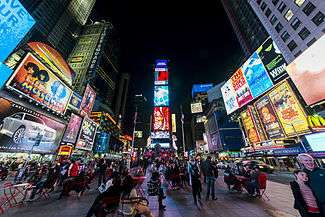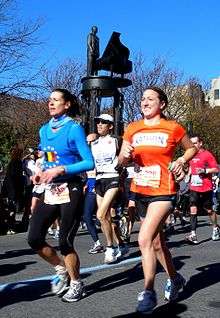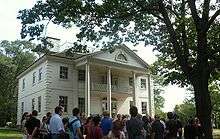Tourism in New York City

Tourism in New York City serves over 50 million foreign and American tourists each year including day-trippers.[2] Major destinations include the Empire State Building, Ellis Island, Broadway theatre productions, museums such as the Metropolitan Museum of Art, and other tourist attractions including Central Park, Washington Square Park, Rockefeller Center, Times Square, the Bronx Zoo, Barclays Center, Coney Island, South Street Seaport, New York Botanical Garden, luxury shopping along Fifth and Madison Avenues, and events such as the Tribeca Film Festival, and free performances in Central Park at Summerstage and Delacorte Theater. The Statue of Liberty is a major tourist attraction and one of the most recognizable icons of the United States.[3] Many New York City ethnic enclaves, such as Jackson Heights, Flushing, and Brighton Beach are major shopping destinations for first and second generation Americans up and down the East Coast.
New York City has over 28,000 acres (110 km2) of parkland and 14 linear miles (22 km) of public beaches.[4][5] Manhattan's Central Park, designed by Frederick Law Olmsted and Calvert Vaux, is the most visited city park in the United States.[6] Prospect Park in Brooklyn, also designed by Olmsted and Vaux, has a 90 acres (36 ha) meadow.[7] Flushing Meadows-Corona Park in Queens, the city's third largest, was the setting for the 1939 World's Fair and 1964 World's Fair.
Industry
| Year | Total Visitors (millions) |
Domestic Visitors |
International Visitors |
Total Visitor Spending Billions(US$) |
|---|---|---|---|---|
| 1991 | 29.1 | 23.6 | 5.5 | 10.1 |
| 1995 | 28.5 | 23.1 | 5.4 | 11.7 |
| 1998 | 33.1 | 27.1 | 6.0 | 14.7 |
| 1999 | 36.4 | 29.8 | 6.6 | 15.6 |
| 2000 | 36.2 | 29.4 | 6.8 | 17.0 |
| 2001 | 35.2 | 29.5 | 5.7 | 15.1 |
| 2002 | 35.3 | 30.2 | 5.1 | 14.1 |
| 2003 | 37.8 | 33.0 | 4.8 | 18.5 |
| 2004 | 39.9 | 33.8 | 6.2 | 21.3 |
| 2005 | 42.6 | 35.8 | 6.8 | 24.3 |
| 2006 | 43.8 | 36.5 | 7.3 | 26.2 |
| 2007 | 46.0 | 37.1 | 8.8 | 30.0 |
| 2008 | 47.1 | 37.6 | 9.5 | 32.0 |
| 2009 | 45.8 | 37.0 | 8.8 | 28.2 |
| 2010 | 48.8 | 39.1 | 9.7 | 31.5 |
| 2011 | 50.9 | 40.3 | 10.3 | 34.5 |
| 2012 | 51.5 | 40.9 | 10.6 | 34 |
| 2013 | 53 | 41.7 | 11.3 | 38 |
| 2014 | 54.4 | 42.5 | 11.9 | 41 |
| 2015 | 55.9 | 43.2 | 12.7 | 45 |
According to NYC & Company, the official destination marketing organization for the city, the top producing countries for international visitors to New York City in 2011 were the United Kingdom (1,055,000), Canada (1,033,000), Brazil (718,000), France (662,000) Germany (587,000), Australia (532,000), Italy (495,000), China (427,000), Spain (422,000), Mexico (376,000), and Japan (299,000).[8] With the exception of slight peaks around Thanksgiving, Christmas and New Year, visitor arrival rates are roughly the same year-round. New York has one of the highest hotel-occupancy rates in the country. Arrivals have remained relatively high even since the global economic crisis, due to heavy discounting and value-added pricing.
Double decker tour buses and boats with tour guides bring sightseers to various parts of Manhattan and other boroughs, while pedicabs and horse cabs serve those with a taste for more personal service. More adventurous tourists rent bicycles at neighborhood shops or along the Manhattan Waterfront Greenway or simply walk, which is often the quickest way to get around in congested, busy commercial districts and a way to appreciate street life.
Many visitors investigate their genealogy at historic immigration sites such as Ellis Island and the Statue of Liberty. Other tourist destinations include the Empire State Building, for 41 years the world's tallest building after its construction in 1931, Radio City Music Hall, home of The Rockettes, a variety of Broadway shows, the Intrepid Sea-Air-Space Museum, housed on a World War II aircraft carrier, and city landmarks such as Central Park, one of the finest examples of landscape architecture in the world. New York City has encouraged tourist shopping by eliminating its sales tax on clothing and footwear. In the past, the World Trade Center was an important tourist destination before the September 11 attacks, which devastated the city and its tourist industry. Tourists were scarce for months, and it took two years for the numbers to fully rebound with fewer international, but more domestic visitors, due in part to an emphasis on "patriotic tourism".[9] The World Trade Center site itself became an important place to visit, and visits to the World Trade Center have increased, especially with openings of new buildings on the site in recent years.
Street fairs and street events such as the Labor Day Carnival in Brooklyn, Halloween Parade in Greenwich Village, and New York Marathon also attract tourists.
|
Tourism companies
New York City law requires all guides to be licensed by the Department of Consumer Affairs.
In 1992, the "Greeter" initiative was founded by Lynn Brooks with the association "Big Apple Greeter" in New York City.[10] The voluntary and personal hosting of tourists should improve the bad image of the megacity. More "Greeter" projects followed in other US-American cities and worldwide. Today, more than 300 volunteers "greet" over 7000 visitors per year in New York City As of 2010.[11]
NYC & Company, the city's official convention and visitor bureau, is currently headed by Fred Dixon. It has offices in 14 countries, including Brazil, Britain, France, Germany, Ireland, Italy, Mexico, The Netherlands, Russia, Spain, Sweden, Japan, Korea and China.[12] NYC & Company is the official source of tourism statistics for the city. The research department develops and distributes comprehensive information on NYC domestic and international visitor statistics and monitors the travel industry's impact on New York City's economy. The department also produces 14 official New York City tourism marketing publications that feature information on member hotels, museums, attractions, theaters, stores, restaurants, meeting venues, and service providers.
Special interest tours
New York City has a rich musical culture and history.[13] Accordingly, numerous jazz, gospel music, rock and roll, rhythm and blues and hip hop tours are available. Popular locations for music tours include Harlem and the East Village.
Food tours are another option for visitors. New York is one of the top culinary destinations in the world. New York's food culture, influenced by the city's immigrants and large number of dining patrons, is diverse. Jewish and Italian immigrants made the city famous for bagels, cheesecake and New York-style pizza. Some 4,000 mobile food vendors, many of them immigrants, are licensed by the city and have made Middle Eastern foods such as falafel and kebabs standbys of contemporary New York street food.[14] The city is also home to many of the finest haute cuisine restaurants in the United States.[15] Food tours allow visitors to try a wide variety of these foods economically and learn about the city's culture.[16] Tour companies include New York Food Tours, Local Finds Queens Food Tours and Rum and Blackbird Tasting Tours.[17]

Visitors to New York City also partake in sports tourism. Sporting events draw tourists to major venues such as the Yankee Stadium, Citi Field, and Madison Square Garden, and to street events such as the New York City Marathon.
New York City is one of the major film capitals of the world. Through specially arranged tours, tourists can visit the scenes of TV shows and movies such as Seinfeld, Friends, Sex and the City, Saturday Night Live, Breakfast at Tiffany’s, Miracle on 34th Street, Godfather, and Taxi Driver.
See also
- I Love New York
- List of famous buildings, sites, and monuments in New York City
- Parks and recreation in New York City
- Category:Festivals in New York City
- List of museums and cultural institutions in New York City
- Hotels in New York City
- Soul Night Events
References
- ↑ Ann Shields (November 10, 2014). "The World's 50 Most Visited Tourist Attractions - No. 3: Times Square, New York City - Annual Visitors: 50,000,000". Travel+Leisure. Retrieved May 6, 2015.
- ↑ "NYC Statistics". NYC & Company. Retrieved 2014-10-29.
- ↑ "Statue of Liberty". New York Magazine. Retrieved 2006-06-20.
- ↑ "Mayor Giuliani Announces Amount of Parkland in New York City has Passed 28,000-acre (110 km2) Mark". New York City Mayor's Office. February 3, 1999. Retrieved 2007-06-06.
- ↑ "Beaches". New York City Department of Parks & Recreation. Retrieved 2007-06-06.
- ↑ "City Park Facts". The Trust for Public Land, Center for City Park Excellence. June 2006. Retrieved 2006-07-19.
- ↑ "General Information". Prospect Park Alliance. Retrieved 2007-06-06.
- ↑ NYC & Company. "NYC Statistics". Retrieved 2006-08-03.
- ↑ New York Daily News, Sept 17 2003 Patriotic boost for city tourism
- ↑ New Yorkers As 'Greeters'. In: New York Times, May 31, 1992.
- ↑ Volunteers give free tours in cities around the world. In: USA Today, August 1, 2010.
- ↑ NYC & Company. "NYC & Company Offices Worldwide". Retrieved 2007-03-25.
- ↑ "Places To Visit In New York City". Pinterest Places To Visit In New York City. Retrieved February 14, 2015.
- ↑ Bleyer, Jennifer (May 14, 2006). "Kebabs on the Night Shift". The New York Times. Retrieved 2006-07-19.
- ↑ Collins, Glenn (November 3, 2005). "Michelin Takes on the City, Giving Some a Bad Taste". The New York Times. Retrieved 2006-07-19.
- ↑ Courtney Hollands, Kara Baskin, and Christie Matheson. "Break Loose". Boston Globe. 28 March 2010. http://www.boston.com/bostonglobe/magazine/articles/2010/03/28/break_loose/?page=3
- ↑ New York Food Tours, http://foodtoursofny.com/index.html; Queens Food Tours, http://queensfoodtours.com, Rum and Blackbird Tasting Tours, http://www.rumandblackbird.com/
External links
| Wikivoyage has a travel guide for New York City. |
- Holy New York - Places of worship in New York City
- NYC Travel Blogs
- NYC Insider Guide
- Localfu - Plan your trip to NYC with a local
- New York City Trip Guide - Travel tips and things to do in New York City
_by_David_Shankbone.jpg)
